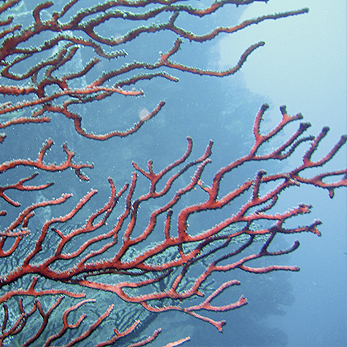Pilot of a new assessment approach
OSPAR has piloted one approach that aims to determine the status of ecosystems building on the identification and quantification of the main pressures and their cumulative impacts on species groups and habitat types. At a workshop held in Utrecht (the Netherlands) in February 2009, over 70 experts in marine science drawn from all OSPAR Regions participated in a trial assessment. The pilot provided important insight into the complexity of assessing ecosystems, and the lessons learnt are an essential contribution to the further development of assessment methodologies. In many cases the results of the Utrecht workshop concur with the findings of the thematic assessments prepared through regular OSPAR work, but there are also many gaps and short-comings, as would be expected when applying a new method to such a complex assessment for the first time. The results are presented in the Utrecht workshop report and Table 11.3 illustrates a possible outcome of impact assessments against pressures to support an overall assessment of quality status per region. The main messages drawn from the Utrecht workshop concern the method itself, the learning process and the way forward.
The Utrecht workshop followed a systematic analytical methodology described by Robinson et al. (2009). The workshop focused on assessing, at the scale of OSPAR Regions, the impact of pressures from human activities, as listed in the EU Marine Strategy Framework Directive, and those driven by climate change, on a selection of four species groups (fish, cetaceans, seals, seabirds) and four habitat types (rock and biogenic reef habitats, shallow sediment habitats, shelf sediment habitats, deep-sea habitats). The assessment process followed a series of steps:
- The first step was to map the geographic distribution of human activities and to describe the spatial and temporal extent, intensity and frequency of the pressures resulting from these activities.
- The second step was to define the geographic distribution of species groups and habitat types that are sensitive to these pressures.
- The third step was to estimate the degree of impact, where pressures and ecosystem elements overlap in space and in time. For this purpose, generic criteria and associated threshold values were developed for geographic range, population size and condition for species groups, and on range, extent and condition for habitats. The threshold values were based on those given in EU guidance for assessing favourable conservation status of species and habitats under the Habitats Directive. The degree of impact, following these criteria, was assessed against a reference status (based on an absence of the pressure). The percentage deviation from this reference status was used to classify the outcome as ‘low’, ‘moderate’ or ‘high’ impact.
- The fourth step was to summarise the different impacts from human activities in order to derive an overall status assessment per species group and habitat type (Table 11.3 for example output).
- Finally, the impacts on all species groups and habitat types were summarised to assess the total impact per pressure Table 11.3 and consequently their relative contribution to the total impact in each Region.
The assessment drew upon data and information on the distribution of the range of human activities presented in Chapters 8 and 9 and the supporting thematic assessments. In some cases, information on impacts from these activities and the status of species and habitats for all OSPAR Regions is very limited. These gaps were filled by collective expert knowledge which was also limited for some Regions and pressures. The level of confidence was determined for each assessment of impact. Lack of consensus among experts was addressed, but could not always be resolved. A review of the method and results of the workshop by ICES recognised that there were shortcomings in the performance of the method which needed to be addressed in its further development. However, the diverse range of experts engaged in the process had clearly added credibility to the expert opinion process.
The Utrecht workshop provided good experience in linking human activities and their associated pressures to the assessment of the selected ecosystem components and trialled a generic, large-scale approach to ecosystem assessment. There are several lessons learnt which inform future work.
- Mapping of human activities and ecosystem components is promising for the assessment of separate and cumulative impacts on habitats and related sessile species (which are bound to a particular area). It seems less applicable to mobile species.
- Assessments at the scale of OSPAR Regions are too coarse to identify properly the often area-specific impacts of human activities. Many habitats also occur at a smaller geographical scale. It is therefore important that assessments of human impacts are undertaken at the appropriate scale, which may vary on a case by case basis.
- Generic assessment criteria and thresholds do not take into account the variation in life history characteristics for some species groups. The assessment criteria should be refined to allow for more differentiation in species and also habitat groups.
- The pilot assessment yields a first indication of cumulative effects. Further development of the method is needed to improve the assessment of cumulative effects.
- Judgement by a designated group of experts following well-defined procedures can complement limited datasets. The credibility of the outcome is enhanced by recording the confidence level and by describing how gaps in data were treated and how issues were addressed for which there was insufficient consensus.
Illustration of results from a pilot assessment...
PDF

